Obstetric Topics
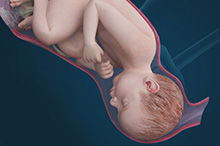
Preterm Labor
Preterm labor is labor that starts before the 37th week of pregnancy. Symptoms can be painful cramping, fluid leaking, and bleeding. There are medications that can be given to slow or stop preterm labor, and there are medications that can be given to the fetus to improve lung development. Preterm labor cannot always be stopped. If a patient has a history of preterm labor, medications can be given during a subsequent pregnancy to reduce the risk of recurrence.
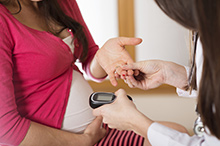
Gestational Diabetes
Gestational diabetes is a form of diabetes that affects some women when they are pregnant. Gestational diabetes increases the risk of a baby being big and increases the risk of the mother having preeclampsia. Pregnant women are screened for gestational diabetes with bloodwork at 24-28 weeks, sometimes earlier if there are increased risks factors like obesity or having diabetes in a previous pregnancy. If gestational diabetes is diagnosed, patients are referred to the Gestational Diabetes Clinic where they are instructed in dietary changes and following blood sugars. Sometimes insulin is needed to control blood sugars. Patients are also followed with ultrasounds in Maternal Fetal Medicine. Blood sugars typically normalize after delivery, and this is confirmed with testing 6 weeks postpartum.

Hypertension and Pre-eclampsia
Blood pressures are carefully monitored in pregnancy. Uncontrolled high blood pressure increases the risks of preeclampsia, placental abruption, preterm labor, and slowed growth of the baby. There are medications that are safe to use in pregnancy to control high blood pressure. Chronic hypertension is a history of elevated blood pressures that occurs prior to pregnancy or is diagnosed during the first 20 weeks of pregnancy. Gestational hypertension is high blood pressure that develops after 20wks gestation. Gestational hypertension usually goes away after delivery, but does increase the risk of developing chronic hypertension down the road. Preeclampsia is a serious condition that usually happens in the 2nd half of pregnancy, and is a disorder of high blood pressure that can be dangerous to both the mother and baby. All patients are screened carefully for preeclampsia. Symptoms of preeclampsia can be new severe headache, right upper quadrant pain, swelling of the face and hands, and spots in front of one's eyes. The diagnosis of preeclampsia sometimes requires early delivery.
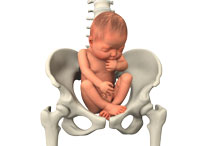
Breech Presentation
In approximately 3-4% of full term pregnancies the fetus has its buttocks, feet, or both presenting in the lowest part of the pelvis. This presentation can be diagnosed by exam and confirmed by ultrasound. Cesarean delivery is recommended for the delivery of breech babies. In order to avoid cesarean your doctor may recommend exercises or acupuncture to try to get the baby to flip into the head down, or vertex, presentation. Attempting to manually turn the baby, also called doing an external cephalic version, may also be appropriate to try.
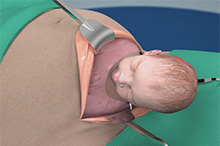
Cesarean Delivery
A cesarean birth is the delivery of a baby through incisions made in the mother’s abdomen and uterus. Some reasons for a cesarean birth are breech presentation, some twin pregnancies, concern for fetal health, medical conditions of the mother, or abnormal progress in labor. Women who deliver by cesarean May have the option to delivery by vaginal birth with subsequent pregnancies.
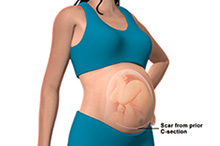
Vaginal Birth After Cesarean (VBAC)
If a women has had a previous cesarean birth she may have the option to deliver subsequent pregnancies vaginally. Not all women are good candidates for a VBAC but a successful VBAC has the benefits of an easier recovery and often fewer complications. There is a small risk of a serious complication called a uterine rupture, where the uterine scar opens prior to delivery. The risks and benefits of VBAC versus repeat cesarean delivery should be reviewed with your physician.

 Menu
Menu








